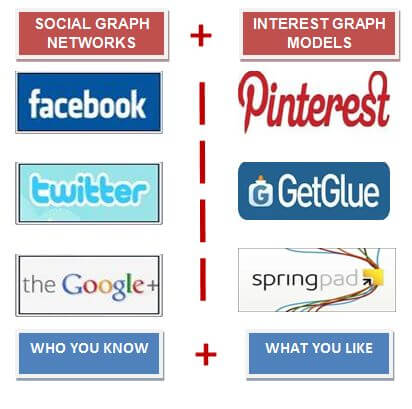Social Graph Enhanced by Interest Graph?
Who you know and what you like. Your Social Graph and your Interest Graph.
Are they mutually exclusive…or complementary? The DigitalEYE Media team thinks you might want to know more about this topic. So here you go…
Brands need the information contained in these graphs if they’re going to effectively market to you and through you.
Up until recently, the emphasis has been on the differences between the Social Graph (which defines who we know and interact with) and the Interest Graph (which defines what we like and, more importantly, what we are most likely to buy).
In his Social Media Today post “Why Online Businesses are Moving from the ‘Social Graph’ to the ‘Interest Graph,’” author David Amerland states that, as social media expands further and becomes more fragmented, it is the Interest Graph that should guide retailers and marketers rather than the social one.
“After all, we never buy anything just because some friends we knew from school bought it too, but the mere recommendation of people we regard as authority on a subject we are intensely interested in, is received, practically, as gospel,” says Amerland.
In “5 Key Components of a Successful Interest Graph,” entrepreneur Moataz Rashad notes that the Interest Graph has been gaining increased attention recently.
“With Google transforming itself into a social company, and even pushing personalized search, it’s clear that the curated Web is a reality,” he says. “Furthermore, the Interest Graph has much more expressive power in the case of the mobile Web. Many mobile interest indicators simply don’t exist on the Web, for example, checkins, location data, near field communication, etc.”
Facebook and its Social Graph
But there’s still that little thing called Facebook, which has at its core what they call the “Social Graph” — people and the connections they have to everything they care about. The Social Graph is not a count of all the people in the crowd. It can be represented in a map of who is connected to whom. A diagram can graphically illustrates a Social Graph system — a spider-web network of interrelations among two or more people indicated by numerous distinctive, connecting dots and lines.
In his ShopIgniter blog titled “The Interest Graph is coming – but don’t forget the Social Graph,'” Matt Compton seeks the preservation of the Social Graph. He says that the emerging Interest Graph is opening up some very exciting new targeting and segmentation opportunities – but,
“We shouldn’t throw the baby out with the bathwater.”
When looking at the Interest Graph vs. Social Graph debate, the fundamental question is: which is more influential – your friends who know you well or people you don’t know who share your same interest?
Of course the perfect influencer would be someone who did know you well and also shared your interest. Because we tend to create our friend networks around our interests, it’s likely that these “perfect influencers” are already part of our Social Graph
“The personal and trust components of a Social Graph can be so much more compelling than that of an Interest Graph,” asserts Compton.
“Even if someone in my Social Graph isn’t an expert in my area of interest, I might be more inclined to trust them with a recommendation for a product because they know me. And I would argue that knowing the characteristics of a person are more important for getting a brand-product-person fit than just having a data value match on interest — skiing, for example. Secondly, the trust factor is powerful driver of actual purchase.”










